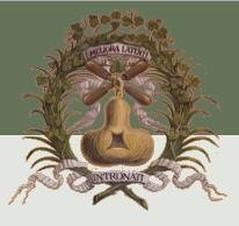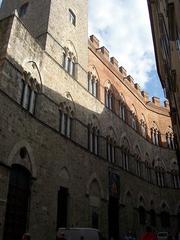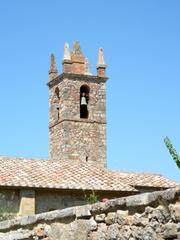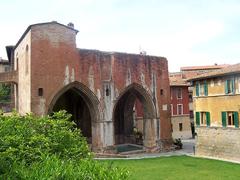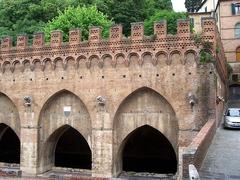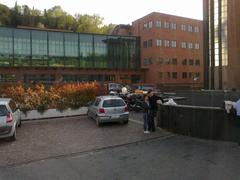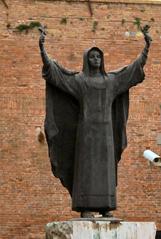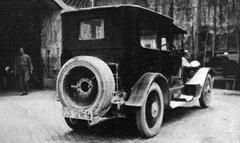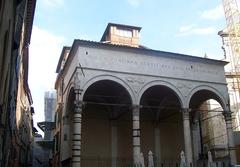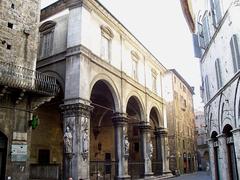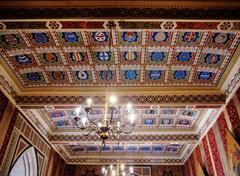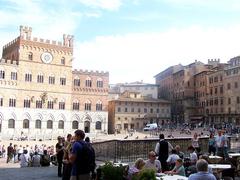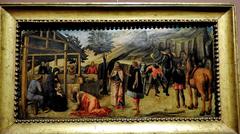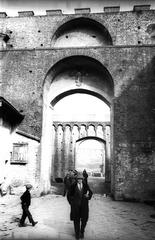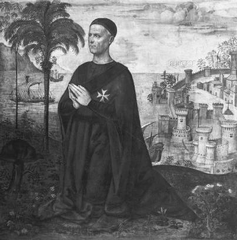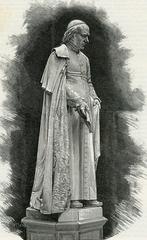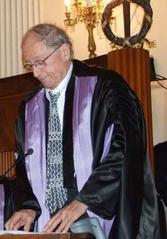Sinagoga di Siena Visiting Guide
Date: 01/08/2024
Introduction
Nestled in the heart of Siena, Italy, the Sinagoga di Siena is a historic and cultural landmark that stands as a testament to the resilience and contributions of the Jewish community. Established in the 17th century and designed by the architect Giuseppe Del Rosso, the synagogue is an architectural gem that blends Rococo and Neoclassical styles, featuring richly decorated interiors that contrast with its simple brick exterior. The Jewish community in Siena has a long and storied history, dating back to at least the 12th century, marked by periods of both flourishing and adversity. Despite facing numerous challenges, including restrictions and the establishment of a ghetto in 1571, the Jewish population of Siena managed to thrive and significantly contribute to the city’s cultural and economic life. Today, the Sinagoga di Siena continues to serve as a place of worship, a cultural hub, and a major tourist attraction, offering guided tours that provide insights into the rich history and heritage of the Jewish community in Siena (Musei Senesi, Visit Jewish Italy).
Table of Contents
- Explore the Sinagoga di Siena: History, Visiting Hours, and Tickets
- Visiting the Sinagoga di Siena: Historical Significance, Tickets, and Hours
- Visiting Sinagoga di Siena: Hours, Tickets, and Essential Tips
Explore the Sinagoga di Siena: History, Visiting Hours, and Tickets
Explore the Sinagoga di Siena: History, Visiting Hours, and Tickets
Introduction
Nestled in the heart of Siena’s historic Jewish quarter, the Sinagoga di Siena stands as a beacon of cultural heritage and resilience. This article will guide you through its rich history, architectural splendor, and practical visitor information, including ticket prices, visiting hours, and nearby attractions, ensuring a comprehensive and engaging experience.
Origins and Early History
The Sinagoga di Siena, located in the heart of the Jewish quarter in Siena, Italy, is a testament to the enduring presence and cultural contributions of the Jewish community in this Tuscan city. The synagogue’s origins date back to the 17th century, a period marked by the expansion of Siena’s Jewish population. The Jewish community in Siena, like many others in Europe, faced various challenges, including restrictions on their residence and professions. Despite these adversities, they managed to establish a vibrant community that significantly contributed to the city’s cultural and economic life.
Architectural Design and Construction
The synagogue was designed by the architect Giuseppe Del Rosso and inaugurated in 1786. Del Rosso’s design reflects a blend of Rococo and Neoclassical styles, which was somewhat unusual for synagogues of that period. The building’s exterior is simple and unadorned, constructed from brick, which contrasts sharply with its richly decorated interior. This architectural choice is typical of synagogues built before the Emancipation, a period when Jews were often required to keep their places of worship inconspicuous.
Inside, the synagogue features a mix of Renaissance, Baroque, and Art Nouveau elements, along with monumental decorations based on Jewish and biblical motifs. One of the most striking features is the ceiling vault, adorned with Stars of David, which were added in 1870. The women’s gallery, created in 1804, is another significant architectural element, reflecting the traditional separation of genders during worship.
Historical Significance
The Sinagoga di Siena is not just a place of worship but also a symbol of the Jewish community’s resilience and cultural heritage. Over the centuries, the synagogue has witnessed numerous historical events that have shaped the Jewish experience in Siena. During World War II, the synagogue suffered damage from bombing but was subsequently restored, preserving its artistic and historical value.
The synagogue also houses antique silverware and ritual vestments, which provide a glimpse into the religious practices and daily life of Siena’s Jewish community. The former women’s gallery is now used for temporary exhibitions and educational activities, further emphasizing the synagogue’s role as a cultural and historical hub.
Memorial Plaques and Commemorations
Visitors to the synagogue and the surrounding Jewish quarter will notice marble plaques inscribed in Hebrew and Italian. These plaques commemorate two tragic events in the history of Siena’s Jewish population. Such memorials serve as poignant reminders of the community’s struggles and the resilience they have shown over the centuries.
Modern-Day Relevance
Today, the Sinagoga di Siena continues to be an important place of worship for the Jewish community and a major tourist attraction. The synagogue is open to visitors throughout the year, but visits are only permitted on certain days and must be booked in advance through Jewish Siena or Opera Laboratori. Guided tours offer a unique opportunity to learn about the history and culture of the Jewish community in Siena, admire the 18th-century frescoes, and understand the building’s multifaceted role as a place for meeting, prayer, and study.
Visitor Information
For those planning to visit, it is essential to check the synagogue’s opening hours and book a guided tour in advance. The Sinagoga di Siena is located in Vicolo delle Scotte, within the former ghetto, making it easily accessible for tourists exploring the historic center of Siena. Tickets can be purchased online through the official websites, and prices typically range from €5 to €10. The Terre di Siena website provides additional information and resources for visitors.
Nearby Attractions and Travel Tips
While visiting the Sinagoga di Siena, consider exploring nearby attractions such as Piazza del Campo, the Siena Cathedral, and the Torre del Mangia. These sites provide a broader context of Siena’s rich history and architectural splendor. Travel tips include wearing comfortable shoes for walking on cobblestone streets and checking local events that might coincide with your visit.
Preservation and Restoration Efforts
The synagogue has undergone various modifications and restorations over the years to preserve its historical and artistic integrity. Notably, the building was renovated and opened to the public in the 1990s. These efforts have ensured that the Sinagoga di Siena remains a well-preserved example of Jewish architectural heritage in Italy.
Educational and Cultural Activities
In addition to its religious functions, the synagogue serves as a venue for educational and cultural activities. The former women’s gallery, now repurposed for temporary exhibitions, hosts events that aim to educate the public about Jewish history, culture, and traditions. These activities are crucial for fostering a deeper understanding and appreciation of the Jewish community’s contributions to Siena’s rich cultural tapestry.
FAQ
What are the visiting hours for the Sinagoga di Siena?
- Visiting hours vary, and it is best to check the official websites for the most current information. Typically, guided tours are available on select days and must be booked in advance.
How do I book tickets for the Sinagoga di Siena?
- Tickets can be booked online through Jewish Siena or Opera Laboratori. Prices usually range from €5 to €10.
Are there any nearby attractions to visit?
- Yes, nearby attractions include Piazza del Campo, the Siena Cathedral, and the Torre del Mangia. These sites offer additional historical and cultural insights.
Conclusion
The Sinagoga di Siena stands as a monument to the enduring legacy of the Jewish community in Siena. Its rich history, architectural beauty, and cultural significance make it a must-visit destination for anyone interested in exploring the diverse heritage of this Tuscan city. Through ongoing preservation efforts and educational initiatives, the synagogue continues to serve as a beacon of Jewish culture and history in Siena.
Call to Action
Plan your visit today and explore the historical and cultural richness of the Sinagoga di Siena. For more information, download the mobile app Audiala, check out other related posts, and follow us on social media for updates and more travel tips.
Visiting the Sinagoga di Siena: Historical Significance, Tickets, and Hours
Visiting the Sinagoga di Siena: Historical Significance, Tickets, and Hours
Introduction
The Sinagoga di Siena, located in the heart of Siena, Italy, is not just a historical and cultural landmark but also a testament to the resilience and contributions of the Jewish community. This guide covers the synagogue’s historical context, architectural significance, cultural importance, and practical visitor information, including ticket prices and opening hours.
Historical Context
The Jewish community in Siena dates back to the 12th century, with the first documented presence in 1229 (Musei Senesi). The community grew substantially over the centuries, despite facing numerous restrictions and challenges. In 1571, Cosimo I de’ Medici established a ghetto in Siena, confining the Jewish population to a specific area near Piazza del Campo (Wikipedia). This ghetto remained in use until 1859, when Jews were emancipated and allowed to live freely throughout the city.
Architectural Significance
Inaugurated in 1786, the Sinagoga di Siena is an architectural gem that blends Rococo and Neoclassical styles. Designed by Florentine architect Giuseppe del Rosso, the synagogue’s exterior is deliberately understated, a common feature of ghetto synagogues, which were often required to blend in with their surroundings (Visit Jewish Italy). The interior, however, is richly decorated, featuring a prayer hall with Ionic pilasters, garlands, and a high barrel vault displaying the Stone Tablets of the Law. The aron (ark) is adorned with marble columns and a tympanum interrupted by a medallion bearing the words “Know before whom you stand.” This aron was donated by the Gallichi family in 1786. The tevah (bimah), a round platform enclosed by a walnut balustrade, dates back to 1756 (Visit Jewish Italy).
Cultural and Religious Importance
The Sinagoga di Siena has been a central place of worship for the local Jewish community since its inauguration. Despite the community’s decline in numbers—from a peak of over 400 members to around 50 today—the synagogue remains active and continues to hold religious services (Lonely Planet). The synagogue also houses ancient Torah scrolls, silverware, and ritual vestments of great value, which are displayed in an adjacent hall (Visit Siena Official).
Commemorative Plaques and Historical Events
Two commemorative plaques are affixed next to the synagogue door. The first, placed on December 5, 1948, honors the fourteen Sienese Jews who were deported and killed in Nazi extermination camps during the Holocaust. The second plaque, added on June 28, 1999, commemorates the bicentenary of the tragic events of June 28, 1799, when thirteen Sienese Jews were burned alive during the devastation of the Sienese ghetto by Viva Maria supporters (Visit Siena Official).
Educational and Cultural Contributions
The Sinagoga di Siena also serves as an educational and cultural center. The women’s gallery, no longer used for services, houses a collection of texts, images, prayer books, and objects that illustrate the centuries-old Jewish presence in Siena. This gallery, arranged on two floors and protected by wooden gratings carved with floral motifs, provides an intimate and evocative space for visitors to learn about the community’s history (Musei Senesi).
The synagogue’s educational center on the top floor hosts temporary exhibitions, workshops, and meetings, further enriching the cultural landscape of Siena (Visit Jewish Italy).
Visitor Information
The Sinagoga di Siena is located at Vicolo delle Scotte, 14, Siena. It is accessible to wheelchair users and offers guided tours that provide an in-depth look at the synagogue’s history and the Jewish community in Siena. Tours depart every 30 minutes, allowing visitors to explore the richly decorated interior and learn about the significant contributions of the Jewish community to the city’s economic and cultural growth (Lonely Planet).
Ticket Prices and Opening Hours
The synagogue and the adjacent Jewish Museum are open to visitors from November 1 to March 31, Monday to Friday from 10:30 am to 3:00 pm, and on Sundays from 10:00 am to 1:30 pm and 2:00 pm to 6:00 pm. From April 1 to October 31, they are open Sunday to Thursday from 10:30 am to 1:30 pm and 2:00 pm to 6:00 pm, and on Fridays from 10:30 am to 3:30 pm. The synagogue and museum are closed on Saturdays and Jewish holidays (Jewish Siena).
Tickets can be purchased on-site or online. Prices for adults are €8, with discounts available for students and seniors.
Travel Tips and Nearby Attractions
For those planning a visit, it is advisable to check the official website for any updates or changes in visiting hours. The Sinagoga di Siena is centrally located, making it easy to combine a visit here with other nearby attractions such as Piazza del Campo and the Siena Cathedral. Public transportation options and parking facilities are readily available.
Restoration and Preservation
The Sinagoga di Siena is undergoing continuous efforts to preserve its historical and cultural heritage. It will be closed from July 18 to August 9, 2024, for restoration work. These efforts ensure that the synagogue remains a vibrant and integral part of Siena’s cultural landscape, preserving its rich history for future generations (Jewish Siena).
FAQ
What are the visiting hours for Sinagoga di Siena?
From November 1 to March 31, Monday to Friday from 10:30 am to 3:00 pm, and on Sundays from 10:00 am to 1:30 pm and 2:00 pm to 6:00 pm. From April 1 to October 31, Sunday to Thursday from 10:30 am to 1:30 pm and 2:00 pm to 6:00 pm, and on Fridays from 10:30 am to 3:30 pm.
How much are tickets for Sinagoga di Siena?
Tickets for adults are €8, with discounts available for students and seniors.
Is the Sinagoga di Siena wheelchair accessible?
Yes, the synagogue is accessible to wheelchair users.
Are guided tours available?
Yes, guided tours are available and depart every 30 minutes.
Conclusion
The Sinagoga di Siena stands as a testament to the resilience and contributions of the Jewish community in Siena. Its rich history, architectural beauty, and cultural significance make it a must-visit destination for anyone interested in exploring the diverse cultural heritage of Siena. Whether you are a history enthusiast, an architecture aficionado, or simply a curious traveler, the Sinagoga di Siena offers a unique and enriching experience that highlights the enduring legacy of the Jewish community in this historic city.
Visiting Sinagoga di Siena: Hours, Tickets, and Essential Tips
Conclusion
The Sinagoga di Siena stands as a remarkable monument to the enduring legacy of the Jewish community in Siena. Its rich history, architectural beauty, and cultural significance make it a must-visit destination for anyone interested in exploring the diverse heritage of this Tuscan city. Through ongoing preservation efforts and educational initiatives, the synagogue continues to serve as a beacon of Jewish culture and history in Siena. Whether you are a history enthusiast, an architecture aficionado, or simply a curious traveler, a visit to the Sinagoga di Siena offers a unique and enriching experience that highlights the resilience and contributions of the Jewish community in this historic city. Plan your visit today and immerse yourself in the historical and cultural richness of the Sinagoga di Siena (Jewish Siena, Visit Siena Official).
References
- Musei Senesi, 2024, Musei Senesi
- Visit Jewish Italy, 2024, Visit Jewish Italy
- Jewish Siena, 2024, Jewish Siena
- Visit Siena Official, 2024, Visit Siena Official
